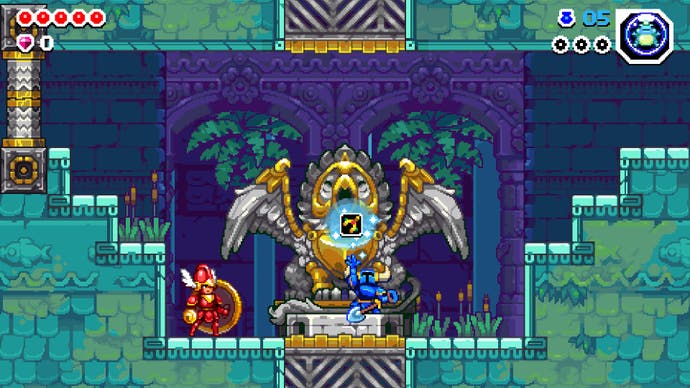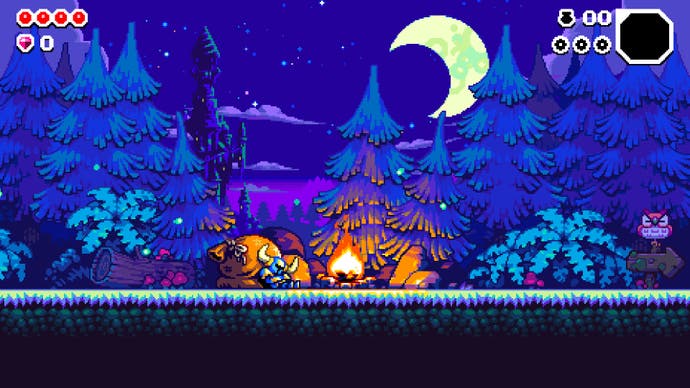Shovel Knight Dig review - a great series safe in the hands of the very best
The trowels are not what they seem.
In the Secret Fountain levels, I fell in love with the water. I didn't notice it at first. I was just digging downwards, flattening baddies with my shovel, enjoying the regular knockabout fun of a 2D platformer. But then I started getting hit by fish. Quite a lot of fish. Fish from the fish cannon, scarlet and slappy and properly doing me in. I realised that the fish moved across the water - they could travel wherever it flowed. And I realised that I could break blocks and channel the water where I wanted it to go. Maybe I could do more than just reroute the fish? What would happen if I steered the water over to that promising waterwheel?
Shovel Knight Dig is a fresh spin on the Shovel Knight series of Duck Tales-inspired platformers. Like Shovel Knight: Pocket Dungeon, it's sort of a sidestory. Pocket Dungeon turned the action-heavy core of the games into a block puzzler. Dig initially seems like a blend of Mr Driller and Downwell. You dig down through soil and rock, collecting gems, fighting baddies, travelling through themed worlds. Classic Driller/Downwell stuff. Thing is, it doesn't feel like either game,
That's because while Dig is a Shovel Knight game and a Yacht Club game, it's also a Nitrome game - it's a true collaboration. And here a little history is unavoidable. Nitrome is an English micro-studio founded in the early 2000s, and I first encountered the team's stuff during the Flash/web-game boom in the years that followed. Nitrome was hard to miss: it delivered games that had a pixelart hard candy exterior - lots of hot pinks and mustards and purples. More importantly its games were marked by wild invention and polish.
The classic Nitrome game took a simple idea - what if you could move the screen around rather than the character, say - and then it did everything you would expect with that idea and dozens of things you wouldn't. Nitrome sounded out possibilities and didn't move on until an idea was absolutely wrung dry. Astonishingly, the quality level was the only thing these games really shared beyond that: they were all great, and they were all different.
(And jeepers, there were a lot of them. If you've ever looked at the timeline of Shakespeare's plays and marveled how he could knock out Measure for Measure and Othello in the same year when it's a struggle to just get the dishwasher fixed, do take a look at this list of Nitrome games on the studio's Wikipedia page. It's all pretty humbling.)

Anyway! With Nitrome involved, Shovel Knight Dig becomes something extremely special. It takes the core of the Shovel Knight game - the fact that you can bounce on your shovel as Scrooge McDuck once bounced on his cane - and the extended cast of knights, and then general tone of luxurious retro fun, and while it always feels like Yacht Club, it spins out something that often feels like classic Nitrome too, in a form that I hadn't seen before.
This is because Shovel Knight Dig is carefully procedural. Each time you drop down into the adventure, the level themes are the same, the level order is the same, and the branching choices are kind of the same, but the stuff you encounter within the levels changes. It's both procedural - a surprise! - and heavily curated, which means you get randomly shuffled set-pieces. So Secret Fountain always has the water, but it doesn't always have the water wheels. And maybe you'll dig through a minefield. Maybe there will be huge chomping snakes hidden in the earth. Maybe fuzzy things will float by that will make you tiny. And maybe being tiny will allow you to explore new areas.
All the themed areas offer something different - I love the industrial lava one, and I love the sort of grim one that followed it - but they all break down into a series of levels, with a choice in between of where you go next. These choices are sometimes locked off, which means you have to find keys. Also, if you collect three cogs within each level, you can unlock a special chest that either refills your health or gives you a treat.

Treats come in the form of relics and accessories - items that give you new abilities, like a boomerang axe or a fireball, or sharpened horns that let you dig upwards. There are also new moves to learn, new armour, loads of stuff that means you can change your playing style as you drop through a world that is also changing. Up on the surface you can pay to unlock new items that you'll then maybe find below, and pay to unlock fast travel to certain areas. Fast travel's handled in a deeply Shovel Knight manner, which I won't spoil. The hub is also riddled with secrets: I've found some and I'm sure there are more. Oh yes, and it's set at a sort of crossroads, so every time you return there are people walking past to chat to. And a nice owl.
What I'm getting at is: this game is made of stuff. And that's the thing that makes it truly brilliant. Above all else, Shovel Knight Dig wants to constantly infuriate you - not in a bad way - with what you miss as much as what you see in each run. Because you're moving downwards - chugging through the earth and also jumping between platforms - there can be things you pass that you just can't get back up to. A golden cog, sure, but also a promising side passage, a new enemy, a nail sticking out of a wall which suggests a secret, a challenge room, a shop with stuff you can't afford at the mo, a bouncepad whose position seems promising. It's a bold move to build the thrill of a game around opportunity cost, especially when what you're thinking is not: I'll check that out next time, but rather: I'll check that out when the game deems to procedurally serve it up again.
As opportunity cost suggests, though, you're often missing things because of choices: you choose this path so the other path can't be taken just now, or you go for the cog, which means that the new power-up will have to wait. It's that mixture of generosity and imagination that Nitrome has been serving up for almost two decades now.
So it's always nice to see a new Shovel Knight game, but Dig is just that little bit more special. If you adore Yacht Club but you don't know Nitrome yet, you're about to fall in love again. Together these teams have made something absolutely luminous. Hark! The endless invention, the desire to get a lot out of a little, the colour, the sense of fun. The boundless imagination and the generosity.



